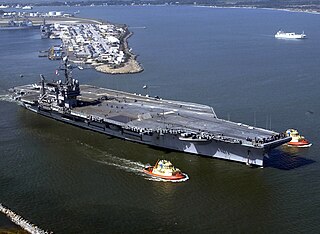
Puget Sound Naval Shipyard, officially Puget Sound Naval Shipyard and Intermediate Maintenance Facility, is a United States Navy shipyard covering 179 acres (0.7 km2) on Puget Sound at Bremerton, Washington in uninterrupted use since its establishment in 1891; it has also been known as Navy Yard Puget Sound, Bremerton Navy Yard, and the Bremerton Naval Complex.

USS Kitty Hawk (CV-63), formerly CVA-63, was a United States Navy supercarrier. She was the second naval ship named after Kitty Hawk, North Carolina, the site of the Wright brothers' first powered airplane flight. Kitty Hawk was the first of the three Kitty Hawk-class aircraft carriers to be commissioned and the last to be decommissioned.

USS John F. Kennedy (CV-67), the only ship of her class, is an aircraft carrier, formerly of the United States Navy. Considered a supercarrier, she is a variant of the Kitty Hawk-class, and the last conventionally powered carrier built for the Navy, as all carriers since have nuclear propulsion. The ship was named after John F. Kennedy, the 35th President of the United States. John F. Kennedy was originally designated a CVA, for fixed wing attack carrier, however the designation was changed to CV, for fleet carrier.

The Kitty Hawk-class supercarriers of the United States Navy were an incremental improvement on the Forrestal-class vessels. Three were built, all in the 1960s, Kitty Hawk (CV-63) (1961–2009), Constellation (CV-64) (1961–2003), and America (CV-66) (1965–1996), as well as the variant John F. Kennedy (CV-67) (1967–2007). All are now decommissioned.

The New York Shipbuilding Corporation was an American shipbuilding company that operated from 1899 to 1968, ultimately completing more than 500 vessels for the U.S. Navy, the United States Merchant Marine, the United States Coast Guard, and other maritime concerns. At its peak during World War II, NYSB was the largest and most productive shipyard in the world. Its best-known vessels include the destroyer USS Reuben James (DD-245), the cruiser USS Indianapolis (CA-35), the aircraft carrier USS Kitty Hawk (CV-63), the nuclear-powered cargo ship NS Savannah, and a quartet of cargo-passenger liners nicknamed the 4 Aces.

USS Halsey (DDG-97) is an Arleigh Burke-class guided missile destroyer in the United States Navy.
133 is the natural number following 132 and preceding 134.
134 is the natural number following 133 and preceding 135.

Strike Fighter Squadron 195 (VFA-195), also known as the "Dambusters", is a United States Navy F/A-18E Super Hornet fighter squadron stationed at Marine Corps Air Station Iwakuni, Japan. They are a part of Carrier Air Wing Five (CVW-5) and their tail code is NF. Their radio callsign is "Chippy".

USS Seagull (AM-30) was an Lapwing-class minesweeper acquired by the United States Navy for the dangerous task of removing mines from minefields laid in the water to prevent ships from passing.

The YMS-1 class of auxiliary motor minesweepers was established with the laying down of YMS-1 on 4 March 1941. Some were later transferred to the United Kingdom as part of the World War II Lend-Lease pact between the two nations. One ship eventually made its way into the Royal Canadian Navy postwar.

The Adroit-class minesweepers were a class of United States Navy PC-461-class submarine chasers completed as minesweepers. However, they were considered unsatisfactory in this role, and were all eventually converted back into submarine chasers.
Several ships of the United States Navy have been named USS Goshawk, after the goshawk, a large, short-winged hawk.
USS Hawk (AM-133) was a Hawk-class minesweeper of the United States Navy during World War II.

USS Auk (AM-38) was a Lapwing-class minesweeper acquired by the United States Navy after World War I to remove mines that had been placed during the war.

Helicopter Sea Combat Squadron 14 (HSC-14) "Chargers" is an aviation unit of the United States Navy based at Naval Air Station North Island, California (USA). HSC-14 was established as Helicopter Anti-Submarine Squadron 14 (HS-14) in 1984 and was redesignated HSC-14 in 2013. The squadron is equipped with the Sikorsky MH-60S Seahawk.










